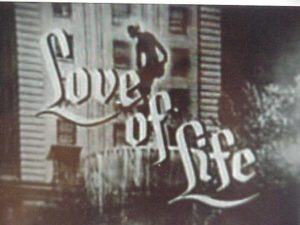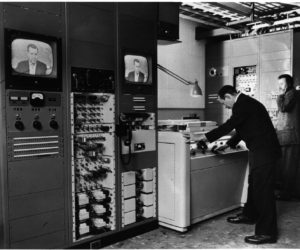
When I was a kid, I noticed something about TV very early in the game: my mom’s “stories,” as she called the soap operas she watched on weekday afternoons, had a different look to them than other shows like Leave It to Beaver or Bonanza.
The look is hard to describe. But there are unmistakable differences.
Later in life, I learned that the soaps were filmed on videotape. The other TV shows were captured on cameras that utilized conventional film.
Go back to the early 50’s, and all shows were caught on film. However, most were captured as kinescopes. The cameras capturing the action were piping their feeds straight to broadcast. The only way to record what they were filming was to point a film camera at a monitor screen. Thus, the quality of the captured show was only as good as the sharpness of the monitor and the focus of the camera. In other words, lousy most of the time.
During that decade, AMPEX, makers of sound tape recorders, was experimenting with putting video on tape. By 1957, they had perfected the process enough that a TV episode was shot for the first time entirely by videotape cameras. This was The Edsel Show, a Bing Crosby-hosted special that was considerably better than its namesake. Rumor has it that a door handle fell off of a car shortly after it was featured on the show.
While many TV shows were captured on film, the process didn’t work well for shows that depended on live audiences. Scenes would often be shot out of sequence and pieced together in the spicing room. When you had three cameras filming live action, there wasn’t any way to put their outputs into one package, short of filming the monitor image.
But if your camera could record to tape, and have its images instantly accessible (i.e. not requiring darkroom developing), that would open up all kinds of new possibilities.
“Terrific!” you might say. “So that means old broadcasts were saved for posterity!” Well, sadly, videotape didn’t make much of an early contribution to the preserving of shows. The 2″ reels cost about $300 in 1950’s money. And coincidentally, they could be erased and reused. Thus, the same reel of videotape might have been used to capture many episodes of the same show only long enough to be rebroadcast three hours later for west coast viewers.

However, many episodes of early videotaped shows have survived. For example, in its second (1960-61) season, six episodes of The Twilight Zone were shot on videotape, in an effort to cut costs. Remember the one where the kid could talk to his deceased grandmother on a toy telephone? Notice how it has a different look and feel from most other offerings.
It was the soaps that embraced the new technology most quickly. They were filmed live on a daily basis, and videotape was perfect for the three-hour rebroadcasts that were essential due to the four time zones that span the US.
In the early 70’s, an interesting trend took place in TV studios. Many sitcoms started to be shot on videotape, giving them a “soap opera” look. Norman Lear was one of the pioneers of the movement, and all of his vast storehouse of comedies utilized videotape.
Lear’s success, driven by ratings giant All in the Family, caused others to switch to the videotape format. Thus, many of our favorite 70’s half-hour comedies, including Barney Miller and WKRP in Cincinnati, have the distinct videotape look.
Nowadays, digital has changed all of the rules. Digitally filmed shows do not have the videotape look, at least to me. Looking at the the current top twenty rated shows, I don’t spot a single one shot on videotape. I’m not sure if the soaps still use them, I haven’t seen one in thirty years. Perhaps a reader can enlighten us.
Videotaped TV episodes have largely been digitized, retaining their original look and feel, but now no longer subject to the deterioration of the tape itself. Many of us have likewise digitized the tapes we shot with our videocams in the 80’s and 90’s for the same reason. And if you haven’t done so yet, you’d better hurry!
So now, when you spot one of the six Twilight Zone episodes that look different from the rest, you, as Paul Harvey would say, now know the rest of the story.